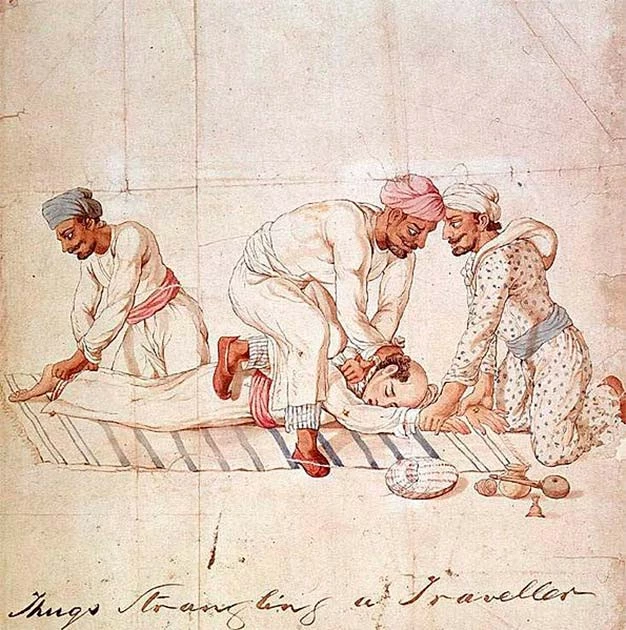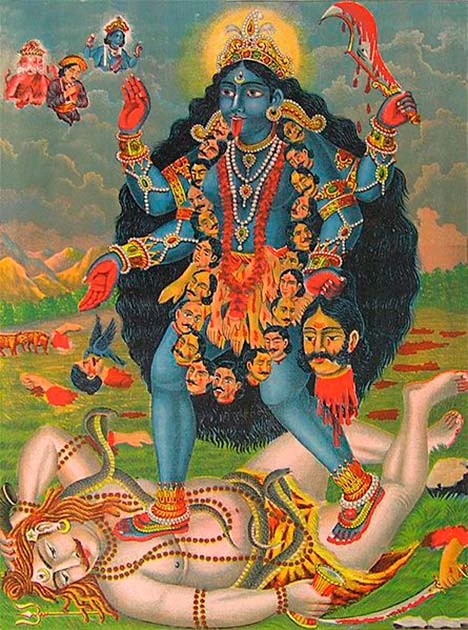In the second Indiana Jones film, Temple of Doom, Harrison Ford is faced with a sinister cult of Kali worshippers who offer human sacrifices and steal the village children. A truly demonic foe, but one which surprisingly has its roots in reality.
In the annals of India’s history, this shadowy criminal cult known as the Thuggees cast a long and sinister presence. For centuries, these secretive criminals roamed the highways of Northern and Central India, leaving a trail of terror and treachery.
By exploring the mysterious world of the Thuggees, examining who they were, where they operated, and what life was like within their ranks, maybe we can try to understand not just their motives but explain their ultimate downfall. After all, this cult of killers was so successful it took the combined might of the British Empire to finally bring their reign of terror to an end.
The Thuggees
The Thuggees were a secretive criminal cult that haunted India from the 14th to 19th centuries. Their name originates from the Hindi word “thag” which means deceiver or thief. It’s not a surprise the name stuck, the Thuggees lived up to it with a chilling precision while operating primarily in the northern and central regions of India, notably in areas such as the plains of the Ganges.
The original Thuggees had a deviously deadly modus operandi. Their nefarious activities revolved around deceiving unsuspecting travelers and caravans.
The Thuggees, often working in groups, would insinuate themselves into the company of these unsuspecting victims, building trust and camaraderie along the way. It was during this facade of friendship that their treachery emerged. The Thuggee had one goal: to murder and rob as many travelers as they could without being caught.

When it came to dispatching their victims, strangulation was the preferred method. They did so using a “rumal”, a knotted handkerchief that every Thuggee carried without fail. To an observer the Thuggees’ targets appeared to be victims of unfortunate accidents or natural deaths, obscuring the gruesome reality of murder.
The Thuggees didn’t pick their targets at random. They specifically preyed on those traveling India’s highways, taking advantage of the vulnerability of travelers in transit. Their criminal network was vast and well-organized, and their crimes were often committed with impunity.
But the Thuggees weren’t ordinary criminals, they were members of a cult that was characterized by secrecy, deception, and the perpetration of heinous crimes. Being a Thuggee took a surprising amount of commitment and joining wasn’t easy.
Individuals often had to go through an initiation process, where they would pledge loyalty to the cult and swear to commit acts of robbery and murder. The initiation was marked by oaths and rituals, further shrouding the cult in mystery.
Their everyday lives were marked by secrecy. Thuggees operated covertly, often disguising themselves as fellow travelers or merchants to gain the trust of their victims. This deception allowed them to get close to their targets, making it easier to execute their criminal activities. The process of befriending and gaining the trust of travelers was a fundamental aspect of their criminal strategy.
Thuggees were not a disorganized band of criminals but a well-structured network. They operated in groups, and members had specific roles within these groups, such as the “Jemadar” who led the gang, and the “Bhuttote” who acted as spies and messengers. This organization allowed them to efficiently execute their crimes and evade law enforcement.
The End of the Thuggees
The Thuggees’ reign of terror did not go unchecked. Their ultimate downfall can be attributed to the intervention of the British colonial authorities, particularly the initiatives led by William Henry Sleeman. Sleeman, a British officer, launched extensive campaigns to suppress the Thuggees and protect the lives of travelers on Indian highways.

Sleeman’s efforts involved extensive investigations and intelligence gathering. He worked diligently to identify Thuggee groups and their members. Once these groups were exposed, a wave of arrests and prosecutions followed.
At the time the Thuggees were even more unpopular than the British which meant the British administration had a key tool in their arsenal: informants. These were men who had once been part of the Thuggee cult but were now assisting in tracking down their former associates.
- London’s Notorious Female Gangsters: The 40 Elephants
- Guns, Gangs, and Getaways: Inside the World of Bonnie and Clyde
The turning point in the fight against the Thuggees was the enactment of the Thuggee and Dacoity Suppression Act in 1836. This legislation allowed for the arrest and punishment of those suspected of being Thugs or “dacoits” (a term used for armed robbers), marking a significant legal move against these criminals. Under the Act, those found guilty of being Thuggees were subjected to harsh penalties, including imprisonment and, in some cases, execution.
The combination of rigorous investigations, the use of informants, and the legal framework of the Thuggee and Dacoity Suppression Act led to the decimation of the Thuggees. The cult’s secretive and criminal activities began to unravel, and many Thuggees were either arrested or forced to renounce their criminal ways. This marked the end of the Thuggees as a powerful criminal organization in India.
A Lost Way of Life
But why did the Thuggees kill? Well according to them, they were heroes rather than villains. Many Thuggee claimed to be the children of the goddess Kali and that they had been created from their sweat. Thuggees interrogated by the British believed that they were saving human lives; their sacred service prevented Kali from destroying all of mankind.
Not all historians are convinced, however. For a start, around one-third of the Thuggees captured by the Brits turned out to be Muslim. They seem to have assimilated Bhavani (another name for Kali) into their own religious beliefs and used her as an excuse to kill, claiming she was a spirit subordinate to Allah.

Which implies the Thuggees used their religion as an excuse. They killed and robbed people because it was profitable and then used ancient folklore to explain their murders. They also justified their crimes to themselves through the use of arbitrary rules. For example some Thuggee sects forbade the killing of women, children, or anyone else believed to be weak or in need.
And ultimately the Thuggees all fell. The Thuggee cult was little more than a glorified criminal endeavor. The memory of the Thuggees serves as a stark reminder that even the most irredeemable of criminals can self-justify their actions.
Top Image: A Thuggee ambush: the traveller is distracted by thugs while one approaches with a garrote from behind. Source: (Capt. James Paton / Public Domain)